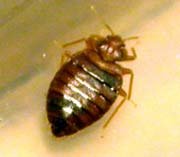Bed bugs in Toronto: A 19th century pest re-emerges in the 21st century

Image: Tim Myles
Resurgence may be due to greater resistance to pesticides, socioeconomic conditions
“Bed bugs were once a common urban plague. But with the development of synthetic insecticides such as DDT and spray systems during the Second World War, they were largely eliminated,” says Dr. Tim Myles, an urban entomologist and author of the study published U of T’s Centre for Urban and Community Studies in a recent research bulletin.
Reports of bed bugs by Toronto pest control companies and pest control officials started to increase two years ago.
In 2002, homeless people told street nurses that bed bugs were a priority medical issue. This year, at least a dozen shelters, hostels, and other forms of public housing had ongoing problems with bed bugs, despite spraying by pest control companies. “The situation merits attentive monitoring. At present, it is not clear to what extent, if at all, such monitoring is currently in place in the Toronto Public Health system,” he says.
What is causing this new resurgence? At present, experts can only speculate that the following factors may be playing a role:
- changes in registered pesticides, use patterns, residual levels, and pesticide resistance;
- socioeconomic conditions leading to increased levels of homeless people living under conditions in which it is difficult to maintain hygiene;
- a populace that has forgotten how to monitor for and control bed bugs;
- greater mobility that allows bed bugs to spread more quickly to a wide number of establishments, including hostels, shelters, dormitories, prisons, hospitals, and hotels.
What can be done to eliminate bed bugs? The research bulletin not only mentions commercial pesticides, but also encourages greater awareness, early reporting, monitoring, cleaning efforts by rooming house and hostel residents, and Integrated Pest Management. Non-chemical approaches include thorough searching and mechanical destruction of bugs and eggs, along with laundering of bedding, frequent vacuuming, and brushing mattress seams. The bulletin also describes the effectiveness of sticky traps and even simple carpet tape, which, placed around a bed or bed legs can trap the bugs.
CONTACT:
Dr. Tim Myles, Centre for Urban and Community Studies, ph: (416) 978-5755; email: t.myles@utoronto.ca
U of T Public Affairs, ph: (416) 978-8638; email: news.events@utoronto.ca
Media Contact
More Information:
http://www.newsandevents.utoronto.ca/bin5/031216a.aspAll latest news from the category: Health and Medicine
This subject area encompasses research and studies in the field of human medicine.
Among the wide-ranging list of topics covered here are anesthesiology, anatomy, surgery, human genetics, hygiene and environmental medicine, internal medicine, neurology, pharmacology, physiology, urology and dental medicine.
Newest articles

Zap Energy achieves 37-million-degree temperatures in a compact device
New publication reports record electron temperatures for a small-scale, sheared-flow-stabilized Z-pinch fusion device. In the nine decades since humans first produced fusion reactions, only a few fusion technologies have demonstrated…

Innovative microscopy demystifies metabolism of Alzheimer’s
Researchers at UC San Diego have deployed state-of-the art imaging techniques to discover the metabolism driving Alzheimer’s disease; results suggest new treatment strategies. Alzheimer’s disease causes significant problems with memory,…

A cause of immunodeficiency identified
After stroke and heart attack: Every year, between 250,000 and 300,000 people in Germany suffer from a stroke or heart attack. These patients suffer immune disturbances and are very frequently…





















